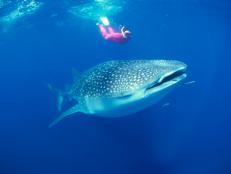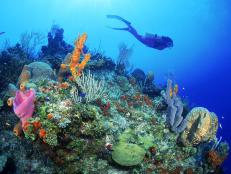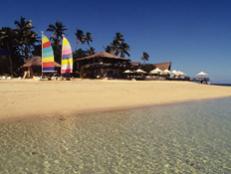10 Great Destinations for Shore Diving
Walk right in from the beach, you don't need a boat to reach these underwater sites where you can explore shipwrecks, coral reefs and a kaleidoscope of colorful creatures.

Related To:
lessRelated To:
1,000 Steps Beach, Bonaire National Marine Park
It's safe to say that Bonaire is the shore diving capital of the world. Bonaire’s entire coral-rimmed coast is designated as a national marine park, and 54 shore dive entry points are marked by yellow rocks that ensure both divers and coral stay safe. Of Bonaire’s many shore dive sites, 1,000 Steps Beach is a standout, and actually, it only has 64 steps that lead into 20- to 100-feet-deep water with temperatures in the 80s. The beach and bottom is white sand, and the coral leads to limestone cliffs filled with sea creatures including hawkbill sea turtles and manta rays, and even the occasional whale shark. Check out Dive Friends Bonaire for more shore dive recommendations, and visit PADI.com for general scuba diving information.
Yatush Wreck at Eilat, Israel
At Eilat in Israel on the Red Sea, shore dive on the wreck of the Yatush, a patrol boat that was purposely sunk in 1986 to create an artificial reef. Today the wreck is covered in coral and home to a myriad of sea life including pipefish, grouper, octopi, eels, seahorses and barracuda. The site is just off of Coral Beach at a maximum depth of 60 feet and marked to protect divers from windsurfers. A wooden ramp leads from the beach to the water for easy entry. Other nearby sites that make Eilat a shore diving haven are the coral reef formations called Moses Rock, Joshua Rock and the wreck of the Satil that lies on a slope that is 36 to 72 feet deep. These are all accessible via a wooden walkway.
Haleiwa Alii Beach Park, Oahu, Hawaii
This is the place to see sea turtles. Oahu’s Haleiwa Alii Beach Park is a standout shore dive in a state known worldwide for its incredible diving. This dive is an easy water entry followed by a shallow swim of 100 meters until you reach a wall that drops to 90 feet. The area is known for its many green sea turtles, moray eels, harlequin shrimp, white-tip reef sharks, lobsters and other sea life making this a year-round dive that is popular at night too.
USS Liberty, Tulamben, Bali
The USAT Liberty was hit by a Japanese torpedo in 1942 and managed to beach near the fishing village of Tulamben in Bali where it rested until 1963 when the eruption of Mount Agung caused it to slip into the water. At its shallowest, the 400-foot-long cargo ship is only 15 feet from the surface and only 75 from shore, making this a great dive for all levels, though only trained divers should ever enter a wreck. Mola mola, whale sharks, black-tip reef sharks and plenty of colorful coral are typically seen here. Though the ship was successfully salvaged, its deck guns and other features are still identifiable.
Million Dollar Point and SS Calvin Coolidge, Espiritu Santo, Republic of Vanuatu
During World War II, the island of Espiritu Santo in the Vanuatu archipelago was a major supply base for the United States in the Pacific Theater. Vanuatu at the time was a joint colony of France and England (it gained independence in 1980). After the war, the U.S. offered to sell the leftover military surplus on the island to France and England, but the two countries figured the U.S. would have to abandon the items and they could just claim the supplies for free. Instead of abandoning the military surplus or giving it away, the U.S. decided to dump it into the sea. It was quite a mess at the time, but today Million Dollar Point is a fascinating shore dive where jumbles of jeeps, trucks, bulldozers, forklifts, boxes of uniforms and even crates of old Coca-Cola serve as an artificial reef that’s home to soft corals, sharks, sea turtles, eels, grouper, lobsters and scores of other species. Entry into the water is easy, as the crushed coral ramp that the Seabees used to drive the equipment into the sea is still there. Nearby, the wreck of the SS Calvin Coolidge begins in 20 feet of water and is still filled with weapons and other U.S. wartime supplies. The ship struck two allied mines near shore with the loss of only two lives, more than 5,340 troops were able to safely make it to shore before the ship sank and slipped into an underwater channel. Today, shore divers can explore the wreck and see the weapons, supplies and even abandoned personal effects of the sailors and soldiers traveling on an ocean liner that was turned into a troop transport ship.
Blue Hole, Gozo Island, Malta
Similar to the famous cenotes of the Yucatan, Malta’s Blue Hole is a limestone cave that’s considered one of the best dive sites in Europe. Called a roofless cave, the Blue Hole is 45 feet wide and descends to 120 feet. About 30 down there’s an arch that opens to the open water and the Coral Gardens that range in depth from 3 to 30 feet. Colorful fish including Mediterranean parrotfish and coral are abundant here. The famous Azure Window, an above-water arch almost 400 feet high that was featured on Game of Thrones, collapsed in March 2017 and is now called the Azure Pinnacle. The area has reopened, and the rubble is quickly becoming home to many new creatures.
Ningaloo Reef, Australia
Australia’s Ningaloo Marine Park protects the country’s largest fringing reef and is accessible just 20 feet from the shore. Located on Australia’s west coast around the North West Cape, Ningaloo Marine Park is known for the whale sharks that feed here from March to June. Humpback whales, manta rays, sea turtles and more than 500 species of fish and more than 200 types of coral make this a bucket list dive — let alone a shore dive — and that’s in a country with the Great Barrier Reef.
Cane Bay, St. Croix, U.S. Virgin Islands
From Cane Bay Beach divers surface swim about 200 yards before reaching a white buoy and descending to the Cane Bay Wall, which is part of the trench that separates the Caribbean Ocean from the Atlantic. The Puerto Rico Trench plunges thousands of feet below (its deepest point is more than 28,000 feet), and all along the trench wall are octopi, seahorses, sea turtles, hundreds of species of fish and coral and even humpback whales in season. In the shallows, before the Wall drops off, someone placed a carousel "seahorse" that is now a popular spot for photos. The Cane Bay Dive Shop at Cane Bay Beach offers tours, rentals and air fills.
La Jolla Cove and Shores, California
Located 11 miles north of San Diego, La Jolla Cove at Point La Jolla is a great shore dive for both beginners and advanced divers who like interacting with seals and sea lions. It is considered one of the best shore diving sites in the U.S. because of its convenience, conditions and diversity of underwater topography. The floor slopes to about 40 feet, and depending on the current, bat rays, sea bass and other wildlife can be seen within its kelp forests, but it’s the playful seals and sea lions that are the main draw here. Across La Jolla Bay is La Jolla Shores, a more advanced shore dive that requires a longer surface swim but leads to trenches filled with life such as nudibranchs, octopi, shrimp, enormous black sea bass, sharks, sea cucumbers, sea urchins and leopard sharks. The entire area is protected by the Matlahuayl State Marine Reserve and the San Diego-La Jolla Underwater Park. SD Expeditions leads shore dive tours of both areas.
Cayman Islands
For shore diving, Stingray City is probably Grand Cayman’s best-known site. Here, you can interact with hundreds of stingrays in 12 feet of water (arrive after 2 pm to avoid the cruise ship crowds), but the island is home to hundreds more excellent shore dives. The wreck of the LCM David Nicholson is easily accessed from shore, and it rests at 30 feet in low-current water with visibility of 90 feet at times. This landing craft was purposely sunk as a reef, and today is covered in colorful coral, tube sponges, fish, eagle rays and the occasional shark and turtle. It’s reached after a 10-minute surface swim out from the Sunset House Hotel on South Sound. Check out some of Grand Cayman’s hundreds of other dive sites here.





